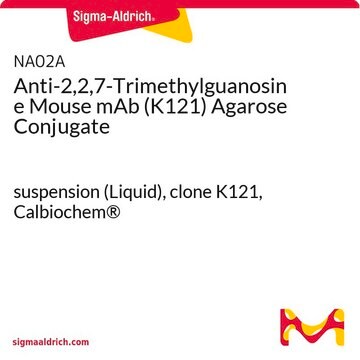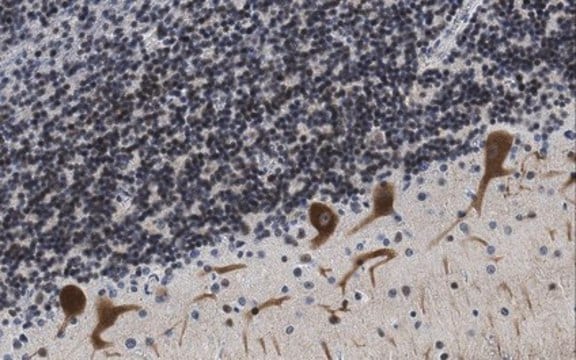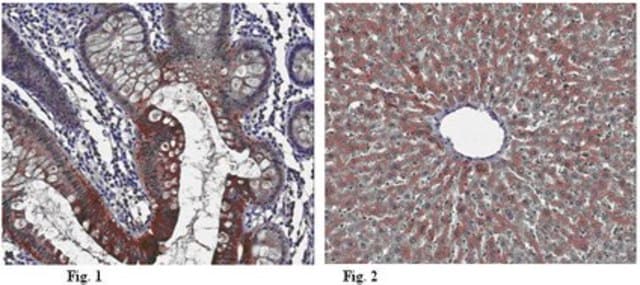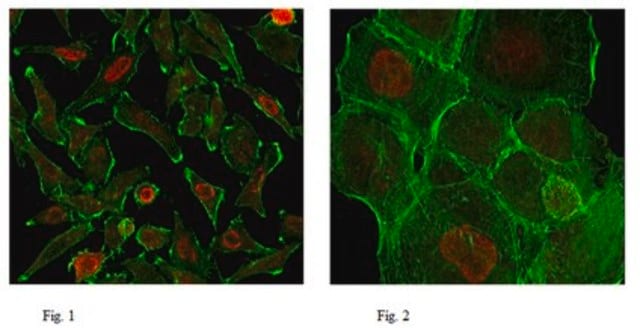推薦產品
生物源
mouse
品質等級
抗體表格
purified immunoglobulin
抗體產品種類
primary antibodies
無性繁殖
K121, monoclonal
物種活性
human, mouse
技術
affinity chromatography: suitable
immunocytochemistry: suitable
immunoprecipitation (IP): suitable
同型
IgG1κ
運輸包裝
wet ice
目標翻譯後修改
unmodified
一般說明
The 2,2,7-trimethylguanosine cap structure is found on the 5’ end of small nuclear RNAs and small nucleolar RNAs. Initially, these RNA molecules are capped with 7-monomethylguanosine (m7G) which is then methylated by the trimethylguanosine synthase enzyme to form 2,2,7-trimethylguanosine. The synthesis of 2,2,7-trimethylguanosine occurs in the cytoplasm and is an important marker for nuclear localization of RNA molecules. Capping of RNAs is an important requirement for RNA transport and splicing processes. Uncapped RNAs are rapidly degraded by the 5′ exoribonuclease enzyme. 2,2,7-trimethylguanosine capping may play a role in the expression of viral RNAs.
應用
Anti-2, 2, 7-Trimethylguanosine Antibody, clone K121 is a high quality Mouse Monoclonal Antibody for the detection of 2, 2, 7-Trimethylguanosine & has been validated in ICC, PAI & IP.
Immunoaffinity Purification Analysis: A representative lot from an independent laboratory was used in IAP (Krainer, A.R., et al. (1988). Nucleic Acids Res. 16(20):9415-9429.).
Immunoprecipitation Analysis: A representative lot from an independent laboratory was immunoprecipitated in IP (Moketi, S., et al. (2002). Mol Cell. 10(3):599-609.).
Immunoprecipitation Analysis: A representative lot from an independent laboratory was immunoprecipitated in IP (Moketi, S., et al. (2002). Mol Cell. 10(3):599-609.).
品質
Evaluated by Immunocytochemistry in NIH/3T3, HeLa, and A431 cells.
Immunocytochemistry Analysis: A 1:500 dilution of this antibody detected 2,2,7-trimethylguanosine in NIH/3T3, HeLa, and A431 cells.
Immunocytochemistry Analysis: A 1:500 dilution of this antibody detected 2,2,7-trimethylguanosine in NIH/3T3, HeLa, and A431 cells.
外觀
Format: Purified
分析報告
Control
NIH/3T3, HeLa, and A431 cells
NIH/3T3, HeLa, and A431 cells
其他說明
Concentration: Please refer to the Certificate of Analysis for the lot-specific concentration.
Not finding the right product?
Try our 產品選擇工具.
儲存類別代碼
12 - Non Combustible Liquids
水污染物質分類(WGK)
WGK 1
閃點(°F)
Not applicable
閃點(°C)
Not applicable
分析證明 (COA)
輸入產品批次/批號來搜索 分析證明 (COA)。在產品’s標籤上找到批次和批號,寫有 ‘Lot’或‘Batch’.。
Cyrille Girard et al.
Nucleic acids research, 34(10), 2925-2932 (2006-06-02)
Neuronal degeneration in spinal muscular atrophy (SMA) is caused by reduced expression of the survival of motor neuron (SMN) protein. The SMN protein is ubiquitously expressed and is present both in the cytoplasm and in the nucleus where it localizes
Magdalena Strzelecka et al.
Nucleus (Austin, Tex.), 1(1), 96-108 (2011-02-18)
The Cajal body (CB) is an evolutionarily conserved nuclear subcompartment, enriched in components of the RNA processing machinery. The composition and dynamics of CBs in cells of living organisms is not well understood. Here we establish the zebrafish embryo as
Ranjodh Sandhu et al.
Cell research, 23(4), 537-551 (2013-03-13)
Telomerase is a ribonucleoprotein enzyme typically required for sustained cell proliferation. Although both telomerase activity and the telomerase catalytic protein component, TbTERT, have been identified in the eukaryotic pathogen Trypanosoma brucei, the RNA molecule that dictates telomere synthesis remains unknown.
Cristina Moreno-Castro et al.
Journal of cell science, 132(22) (2019-10-23)
Cajal bodies are nuclear organelles involved in the nuclear phase of small nuclear ribonucleoprotein (snRNP) biogenesis. In this study, we identified the splicing factor TCERG1 as a coilin-associated factor that is essential for Cajal body integrity. Knockdown of TCERG1 disrupts
Simon Henriet et al.
Current biology : CB, 29(19), 3193-3199 (2019-09-24)
An overwhelming majority of eukaryotic introns have GT/AG ends, whose identities play a critical role for their recognition and removal by the U2 spliceosome, a well-conserved complex of protein and RNAs. Introns with other splice sites exist at very low
我們的科學家團隊在所有研究領域都有豐富的經驗,包括生命科學、材料科學、化學合成、色譜、分析等.
聯絡技術服務








